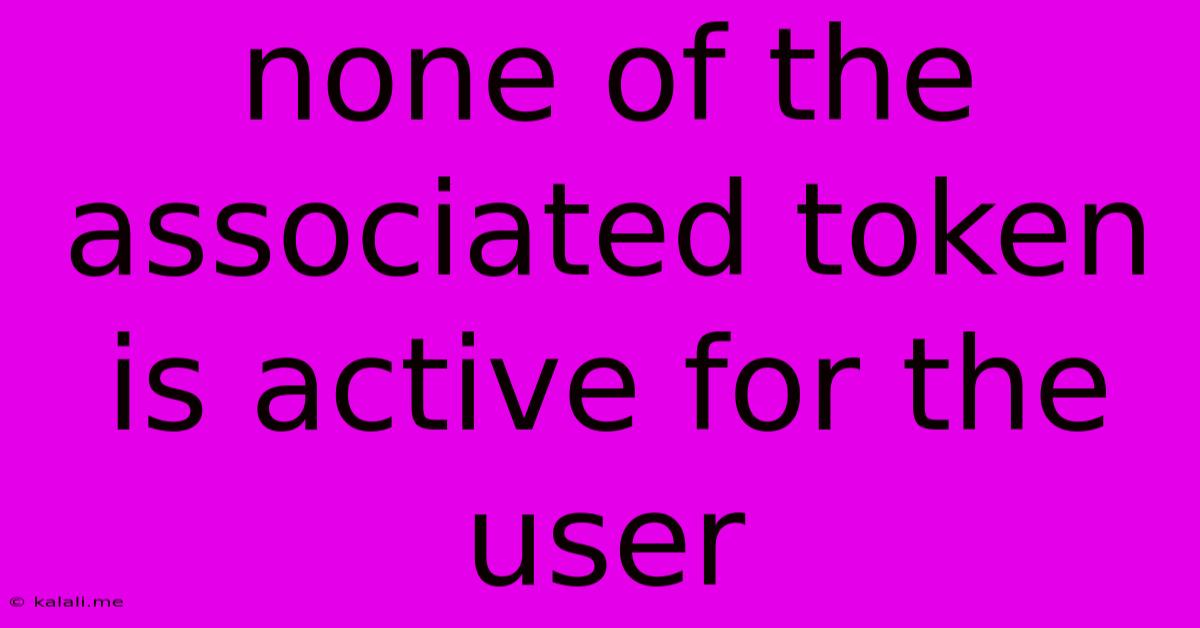None Of The Associated Token Is Active For The User
Kalali
Jun 07, 2025 · 4 min read

Table of Contents
None of the Associated Tokens Are Active for the User: Troubleshooting and Solutions
This error message, "None of the associated tokens are active for the user," typically arises when an application or service attempts to authenticate a user but fails to find a valid access token. This can be frustrating, but understanding the underlying causes can help you resolve the issue quickly. This article will explore the common reasons behind this error and provide practical troubleshooting steps. We'll cover topics ranging from token expiration to potential API misconfigurations.
What Causes "None of the Associated Tokens Are Active for the User"?
This error usually stems from problems with authentication tokens, crucial for verifying a user's identity within a system. Several factors can lead to this issue:
- Expired Tokens: Access tokens have a limited lifespan. Once they expire, they become invalid, resulting in this error. This is the most common cause.
- Revoked Tokens: A token might be intentionally revoked by the user or the system administrator, for security reasons. This could be due to suspicious activity or a deliberate action to invalidate access.
- Incorrect Token Usage: The application might be attempting to use a token that's not intended for the current request or API endpoint. This often happens with inconsistent token management.
- API Configuration Errors: Problems with the application's configuration, especially how it interacts with the authentication server, can prevent it from obtaining or using a valid token.
- Network Issues: Temporary network disruptions or connectivity problems can interrupt the process of obtaining or validating tokens. This can lead to seemingly random error occurrences.
- Database Errors: In some cases, the database storing user information and tokens may have encountered an issue, preventing access to the active token information.
- Server-Side Issues: Problems with the authentication server itself, including outages or malfunctions, can directly cause this error.
Troubleshooting Steps: A Practical Guide
Let's delve into actionable steps to diagnose and resolve this error:
1. Check Token Expiration:
- Verify the token's expiration time. Most APIs provide a method to retrieve this information. If the token has expired, you'll need to obtain a new one using the appropriate authentication process. This often involves re-authenticating the user.
2. Investigate Token Revocation:
- Check if the token has been manually revoked. Consult user account settings or administrative logs to determine if this action has occurred.
3. Verify API Integration:
- Carefully review your application's code, ensuring it correctly handles tokens and communicates with the authentication server. Pay close attention to the API calls and ensure you are using the right endpoints and parameters.
4. Examine Network Connectivity:
- Confirm your application has stable internet connectivity. Temporary network outages can cause authentication failures. Testing the network connection independently can be helpful.
5. Check API and Server Status:
- If possible, check the status of the relevant API or authentication server. An outage or maintenance could be the culprit.
6. Database Integrity:
- If you have direct access to the database, check for any inconsistencies in the user's token data. A corrupted entry could prevent the system from identifying an active token.
7. Review Authentication Process:
- The entire authentication flow, from initial login to token generation and usage, needs a thorough review. Look for any potential gaps or errors in the procedure.
8. Consider Refresh Tokens:
- Many authentication systems utilize refresh tokens. These tokens allow you to obtain new access tokens without requiring the user to re-authenticate. Check if your system supports refresh tokens and utilize them to extend the validity of your access tokens.
Prevention is Key: Best Practices for Token Management
Proactive measures can minimize future occurrences of this error:
- Implement robust token management practices, including secure storage and timely rotation of tokens.
- Use a suitable library or SDK for handling authentication tokens, simplifying the process and minimizing errors.
- Regularly test your application's authentication functionality.
- Implement proper error handling in your application code to gracefully manage token-related issues.
By systematically following these troubleshooting steps and adopting best practices, you can effectively address the "None of the associated tokens are active for the user" error and ensure the smooth operation of your application. Remember to consult your specific application's documentation and API specifications for detailed guidance.
Latest Posts
Latest Posts
-
What Is It Called When Everyone Plays Together
Jun 07, 2025
-
Can You Pour Concrete In Sections
Jun 07, 2025
-
How To Lower Water Level In Toilet Bowl
Jun 07, 2025
-
La Vie Est Belle Meaning In English
Jun 07, 2025
-
Can Bed Bugs Live In Wood
Jun 07, 2025
Related Post
Thank you for visiting our website which covers about None Of The Associated Token Is Active For The User . We hope the information provided has been useful to you. Feel free to contact us if you have any questions or need further assistance. See you next time and don't miss to bookmark.